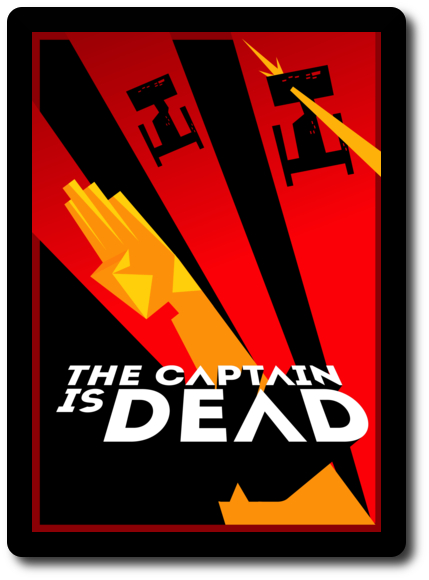
The Basics:
- For ages 8 and up (publisher suggests 12+)
- For 1 to 7 players
- Approximately 60 minutes to complete
Geek Skills:
- Active Listening & Communication
- Counting & Math
- Logical & Critical Decision Making
- Reading
- Pattern/Color Matching
- Strategy & Tactics
- Risk vs. Reward
- Cooperative & Team Play
- Hand/Resource Management
Learning Curve:
- Child – Easy
- Adult – Easy
Theme & Narrative:
- In space, no one can hear you scream in frustration
Endorsements:
- Gamer Geek approved!
- Parent Geek approved!
- Child Geek approved!
Overview
The Captain was always considered to be a bold and brave woman. She had won many battles and fought many a gruesome alien foe. When she died from choking on a pickle slice during lunch, she was just as surprised as her crew. It was the explosion that caused the Captain to inhale quickly and now the crew are scrambling to fix the problems and save the spaceship. They should put warning labels on those pickle jars…
The Captain Is Dead, designed by Joe Price, JT Smith, and published through the Game Crafter, is comprised of 16 Battle Plan cards, 24 Yellow Alert cards, 26 Orange Alert cards, 6 Red Alert cards, 2 Yellow Status bars, 1 Orange Blocker bar, 7 Torpedoes, 30 pawns (60 pawn stickers are included), 48 Skill cards (covering “Command”, “Tactical”, “Engineering”, and “Science” areas), 18 Role cards, 6 System cards, 5 Upgrade cards, 5 Tool cards, and 1 game board (that represents the deck of the spaceship). The cards are as thick and as durable as your standard playing card. The Torpedoes and pawns are made of solid plastic. The game board is made of thick cardboard and very durable. The illustrations by Gaetano Leonardi are colorful and highly stylized, giving the game a unique feel.
Game Set Up
Note: Prior to playing your first game, stickers will need to be applied to each pawn. All hostile alien stickers are attached to the black pawns. Crew stickers are attached to pawns that match the illustrated crew member’s uniform color.
To set up the game, first place the game board in the middle of the playing area. All players should be able to easily reach the game board.
Second, place the 6 System cards on their designated spot on the game board. The “Online” side of the System cards should be face-up.
Third, place the 5 System Upgrade cards on their designated spot on the game board. The “Inactive” side should be face-up.
Fourth, place one Yellow Status bar on the “100%” spot on Shields track found on the game board and one Yellow Status bar on the Jump Core track difficulty setting of the group’s choice. The more difficult the setting, the more difficult the game. I recommend you introduce The Captain Is Dead to new players using either “Novice” or “Normal”. The “Coward” setting is too easy to provide much of a challenge or fun unless you are teaching a cooperative game for the first time.
Fifth, separate the 3 Alert decks by color (Yellow, Red, and Orange) and shuffle each individually. Place the Red Alert cards on the bottom, then place the Orange Alert cards on top, and then place the Yellow Alert cards on top of the Orange Alert cards creating a single deck. Place the Alert deck on the designated spot on the game board and draw the first 2 cards (which should be Yellow Alert cards), placing them next to the deck. These cards forewarn the players what is to come.
Sixth, shuffle the Battle Plan cards to form a single deck. Place the Battle Plan deck face-down on the designated spot on the game board.
Seventh, shuffle all the Skill cards together to form the Skill deck. Draw 3 Skill cards and place face-up on the designated spot on the game board. Then deal 5 Skill cards to each player. The Skill deck is placed face-down on the designated spot on the game board and each player selects 1 Skill card from their hand to add to the “Cargo Pod” space on the game board. Any Tool cards are placed in the Cargo Pod, as well.
Eighth, place the Orange Blocker bar near the Engineering section of the ship, but not on the ship. This will be used later in the game. Place the 12 Hostile Alien pawns off to one side, as you’ll need them later, as well.
Ninth, place 5 Torpedoes on the red spaces next to the “Torpedo Tube” space on the game board. The remaining 2 Torpedoes are placed on the grey spaces.
Tenth, give each player a Crew pawn of their choice or hand them out randomly. Any pawns not used are returned to the game box. Then give each player the matching colored Role cards. Each player should now review the roles, discuss what should be taken, and select 1 to play with. The Role card the player wants to use is placed face-up in front of them. The Role card not used is placed face-down next to the face-up card. The face-down Role card is used as reference.
Eleventh, each player now places their pawn in the starting location on the spaceship. Starting locations match the color of the player’s pawn.
That’s it for game set up. Time to see if this crew has what it takes to survive!
A Quick Tour of Your Ship
The spaceship the players are on is hurting and needs to be fixed if the players want to win the game. The game board depicts the spaceship’s deck plan. Rooms where actions can be taken are shown, along with the ship systems that can be interacted with. Players should familiarize themselves with each system on the game board before playing. Failure to do so will make it very difficult to win the game. Each room has a dotted line that leads to the system that can be found on it. This allows players to occupy rooms with their pawns without blocking or covering up what the system can do.
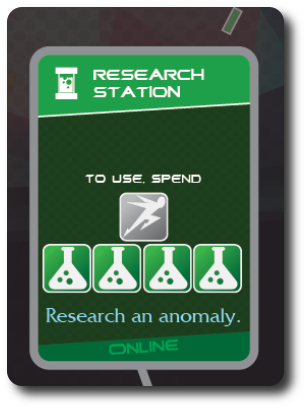
Players should think of systems on the spaceships as equivalent to organs in a person’s body. If an organ or system shuts down, the body (or spaceship, in this case) begins to die. As the game progresses, various systems will shut down requiring players to go to the room where the system is found and repair it. When systems are online, they provide an “Always-On Ability” that continues to work regardless if a player is there or not and an action that a player can take by spending actions.
When a system goes offline, the bonuses they provide are no longer available. Repairing them will allow the system to come back online. Which brings us to the crew…
Elite Crew Members of the Most Elite
Each Role card lists the name of the crew member, their rank, hand size, actions, and additional abilities. The secondary Role card that is placed face-down has additional information on inherent abilities and actions.
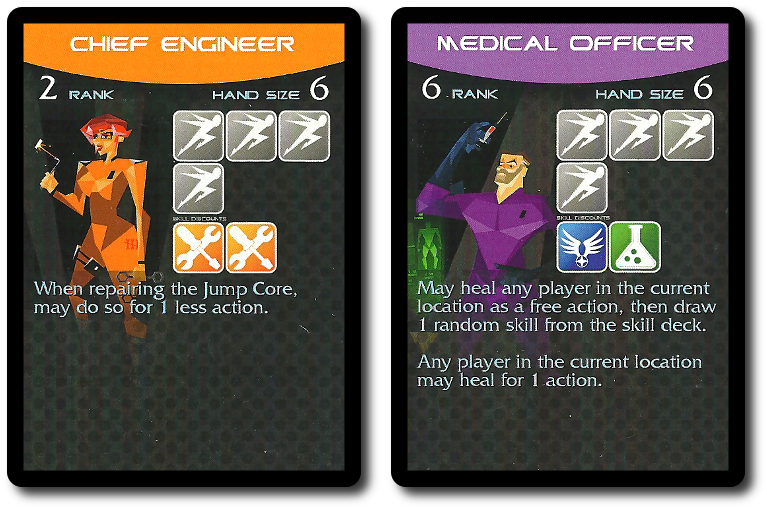
Each system found in the rooms of the spaceship list the cost to use the ability they provide. The cost is paid by spending actions, but an action can be used for more than just fixing systems. For 1 action, the player can move up to 2 spaces in the spaceship, kill 1 hostile alien, carry another player, give a skill or tool to another player, or take a skill or tool from another player.
ALARM!!!!
The Captain Is Dead is played in rounds and turns. The turn order sequence is determined by the Role card rank value. Lowest rank goes first, followed by the next lowest and so on. Players might want to consider rearranging themselves so they are sitting in the correct turn order, but it’s not necessary to do so.
Before the game begins, 5 Alert cards are drawn 1 at a time and placed face-up next to the Alert deck. Two have already been drawn and must be resolved first. When an Alert card is drawn, it’s read and immediately resolved. Any and all damage to the spaceship and systems during this initial start cannot be blocked or avoided. Systems may or may not go offline. Long story short, the poop just hit the proverbial fan. When the Alerts have been drawn and resolved, the game can begin starting with the player with the lowest ranked Role card going first.
The Captain Is Dead is a cooperative game. All players are working together as a team. If they fail to do so, they will lose. No one player is more important than another and no one is the “boss”. Players should feel free to do what they think is necessary, but never lose sight of the fact that they cannot beat the game alone. Communication and cooperation is crucial to the players’ success.
A player’s turn is not something that can be easily documented or even summarized. What a player will and will not do is based on 3 important things.
- Immediate threats
- Available skills
- Location
Immediate threats are somewhat vague at first. Yes, lots of things are going wrong, but it can be difficult to determine what system is or is not a high priority. Players should discuss what should or should not be tackled. Table talk is not only encouraged, but absolutely required. If a player thinks they are the right person to tackle an issue, they should explain why and get feedback from the group. Of course, they could just go and do it, too. Nothing is stopping the player from being a loose cannon.
A player’s available skills are based on what the Role card lists and the Skill cards they have in their hand. Any Skills listed on the player’s Role card are considered “discounts”, but it might be easier to just consider them as bonuses, as they are built-in knowledge that can be used again and again. For example, if the Role card had listed 2 “Tactical” Skills, that would mean the Role card already provides 2 “Tactical” Skills towards the total requirement. Or, if you like, reduces the total requirement. Up to the player to determine how best to interpret it. Regardless of how they do, Skill cards are played and discarded to pay for whatever the player’s Role card does not provide. Tools can also be used and last a bit longer than Skill cards, having an “A” and “B” side. This means each Tool can be used twice. Tools can also be transferred to another player, either by hand or using the spaceship’s Teleporter.
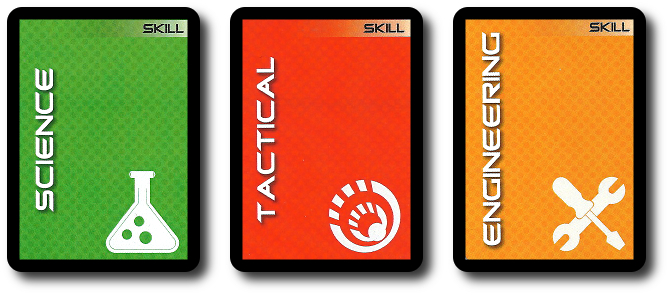
Where the player is located will determine what system is best to go fix. Each room and corridor is considered 1 space. Moving from 1 space to another using doors that connect them will reduce the player’s total number of actions they can use during the round. Again, actions are like a resource. The player will always have them, but they will not be able to use any more per turn than what their Role card lists. Players should keep this in mind before traveling to a new location on the spaceship. If they fail to do so, they might find themselves at their desired location but unable to do anything with the system it contains. Some locations will contain more than one system to interact with. For example, a player in Engineering can access the Jump Core and the Teleporter.
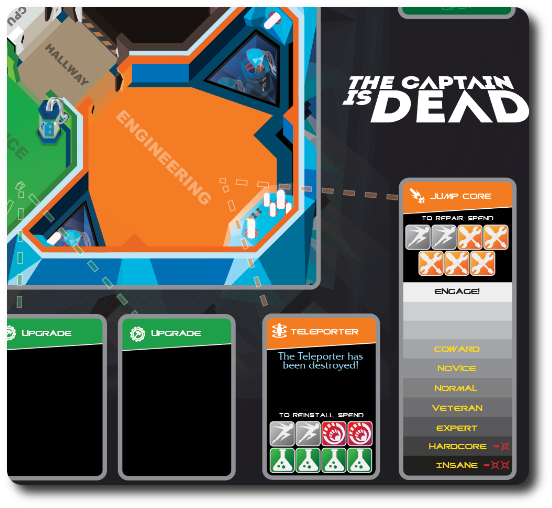
If a player wants to use or repair the Teleporter, they will need to go to Engineering
Using Systems
If a system is online, it can be used by the player. Not all systems go offline, thank goodness. Additionally, not all systems require the player to be in the same location as the system to use it. For example, the “External Scanners” system allows all players to see what Alert cards are coming before they are played. Recall that when the game was set up, 2 Alert cards were dealt face-up, warning the players what was to come. Other systems, like the “Computers” system, require the player to activate it to use it.
Some Role cards list an ability that is associated with a system. If that system is active (“online”), the player can use the ability listed on their Role card. If the system goes down (“offline”), the ability is temporarily unavailable until the system is repaired.
Players can also upgrade the ship, adding new systems not initially in play. The “Science Lab” room of the spaceship allows players to research and bring into play upgrades that will permanently provide a bonus.
When a system is damage, its System card is flipped from the “online” side to the “offline” side. The “Shields” and “Jump Core” systems are a bit different. “Shields” system uses a percentage track and the “Jump core” system uses a box track to record how close the Jump Core is to being ready to use.
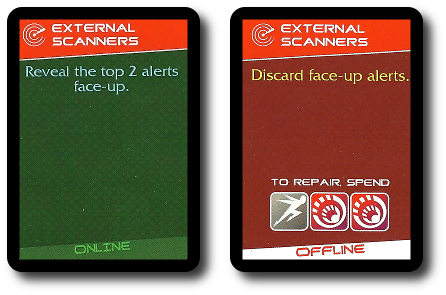
Some systems can be destroyed by an Alert card. If a system is damage and already “offline”, it remains “offline”. Lucky for the players, destroyed systems can be replaced, but it’s not cheap. A player must spend 2 actions, 2 “Tactical” Skills, and 4 “Science” Skills to replaced a destroyed system.
Battles and Injury
The Battle Plan cards give the players a really big advantage, but it’s fleeting and the card can only be used once. They are not necessary to win, but they certainly can help. Battle Plan cards always override any other rule in the game, making them very powerful and legit rule breakers. Battle Plan cards are kept in the player’s hand, but do not count towards the player’s hand size limit.
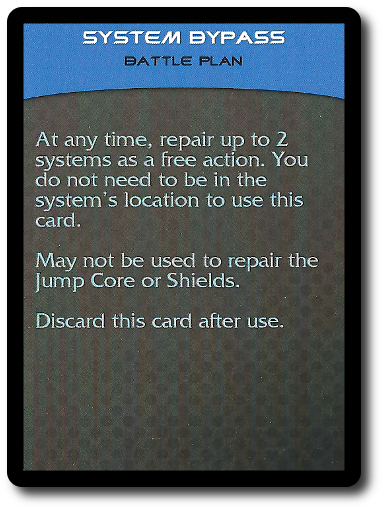
Aliens will invade the ship, but they do not move or attack. Think of them as nothing more than obstacle for the players to overcome. When an Alien pawn occupies a room with a system, a player cannot interact with the systems in that location until the Alien pawn is removed. Killing an Alien pawn takes 1 action. Not all systems are unavailable when an Alien is nearby.
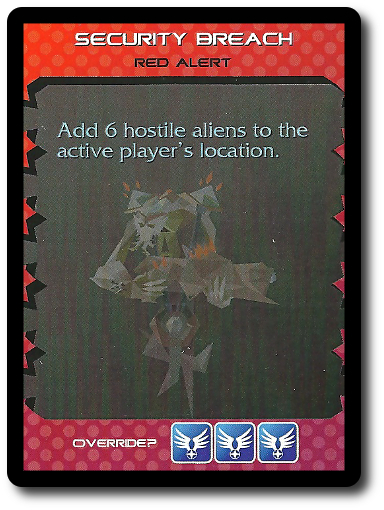
Alien ships are an extension of the Alien pawns. They are allies to the spaceship that is attacking. Torpedoes can be fired to remove Alien Ships, thus reducing the risk temporarily. Players should make use of their “External Scanners” system to fight the Alien Ships by firing at enemy spaceships that are visible. This is an effective way of removing threat without the need to draw a new Alert card.
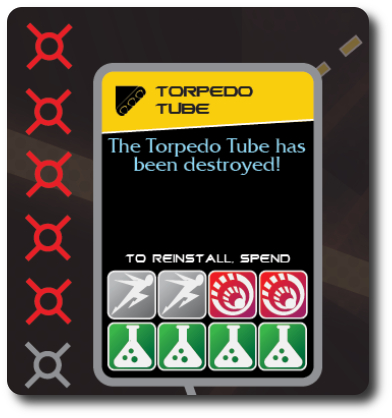
During the course of the game, members of the crew will become injured. Players tip their pawn on its side to signify the damage the crewman has taken. Injured crewman can only move, take out alien invaders, use the Teleporter, or the make good use of the Trauma Station. A few systems on the spaceship are also accessible to an injured crewman, but not many. It’s always better to be upright and able, but injured crew members are still able to get the job done.
Alerts
When players have completed their turn, they draw 1 Alert card, read it out loud, and resolve it. Alert cards do a lot of nasty stuff, from damaging systems to teleporting Alien invaders. One thing is for certain: they are random and never stop coming.
At the cost of 3 “Command” Skills, a player can override (“block”) some Alert cards as soon as they come into play. This does not require an action, but it can only be blocked by the player who is resolving the Alert card. This means players need to consider not only what they are going to do on their turn, but what Skills they need to keep at the end of their turn if they are to stop an Alert.
Anomalies can occur when an Alert card introduces them to the game. Anomalies are very, very bad things and should be taken care of as soon as possible. Anomalies continually hamper all the players. Tackle them and tackle them fast.
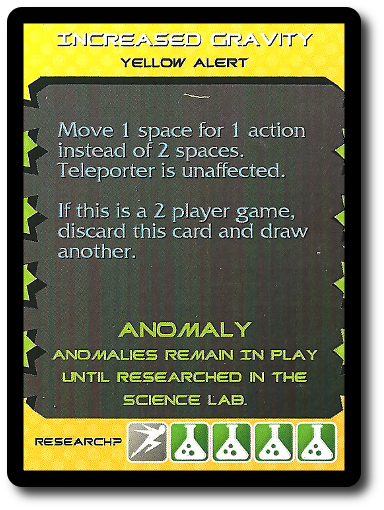
Winning and Losing the Game
The game can only be won if the players are able to fix the Jump Core and move it to the “Engage!” status. BOOM! They jump to safety and can limp the rest of the way home to bury their captain with honors.
The game can be lost if any of the following conditions occur during a player’s turn:
- “Shields” drops to 0% (ka-boom)
- If directed to place an Alien, but all Alien pawns are currently in use (the spaceship has been overrun)
- Fall victim to the Red Alert cards, which are specifically designed to make the players lose the game
- If directed to draw an Alert card and the player cannot, the Alien spaceship blows the player’s spaceship to space dust
Game Variants
Several game variants are provided for those players who want to change-up their game play. Each are summarized here.
A Quicker Game
If players want to reduce the time it takes to play a game (and their odds of survival), remove the Orange Alert cards from play during game set up. Players will now jump from Yellow Alert to Red Alert, followed by an exploding spaceship.
Even Quicker Game
Randomly select 5 Yellow Alert cards to play with and remove the Orange Alert Cards. Players have even less time to make things right on their ship and to get the heck out of enemy space. Odds are very good the players will not win.
Roles for Everyone
Instead of forcing each player to take 1 of 2 roles of a specific color, allow players to select any role they like. This means the ship might have overlapping and multiple roles. Not a bad thing, but it will force players to make up for their role diversity shortcomings.
Captain’s Log: The Crew is Safe. It’s Up To Me…
This solitaire game variant lets a player take on the role of the Captain who has stayed behind to save the ship after the rest of the crew has jettisoned to safety. The same rules apply, but the player’s Captain character is comprised of 3 to 4 Role cards. The Captain isn’t dead yet…
To learn more about The Captain Is Dead, visit the game’s web page.
Final Word
Note: When playing The Captain Is Dead for the first time with Child Geeks, set the game’s difficulty to the easiest setting (“Coward”). The game is not difficult to teach or to learn, but we have observed that an easier level of difficulty in the game allowed the Child Geeks the time to get used to working as a team.
The Child Geeks very quickly learned how to play the game and jumped into the action. The Captain Is Dead is a very easy game to teach due to its straightforward game play. The only difficulty a player will ever have during the game is keeping their cool. Which, as it turned out, the Child Geeks had difficulty doing. According to one Child Geek, “I know we can save this ship if the other players would just listen to me!” The Captain Is Dead is a cooperative game, and like all cooperative games, it was full of player who thought they were the boss. As one Child Geek put it, “Playing this game is fun, but I think I like playing it with adults better. At least adults will listen and work together.” Once the Child Geeks started working as a team, they were able to save the spaceship, but not before. When the games were over, all the Child Geeks voted to approve The Captain Is Dead, finding it to be a thematically entertaining and terribly frustrating game.

My two Junior Crewmen argue about what systems need to be fixed first…
The Parent Geeks had no issues following orders and taking turns directing fellow team members. The biggest issue the Parent Geeks had was spending too much time fixing systems that turned out to be unnecessary. As one Parent Geek put it, “It never fails. When a system goes offline you feel compelled to immediately go fix it, but that’s a mistake. If you don’t need the system, don’t touch it. Save those Skill cards!” Another Parent Geek said, “This game plays really well with mixed groups and I have yet to walk away from it feeling unhappy. I’m really enjoying this.” All the Parent Geeks found The Captain Is Dead to be highly thematic, challenging, engaging, and a lot of fun. They all voted to approve the game.
The Gamer Geeks also enjoyed it, praised the game’s colorful design, smart layout, and high level of strategic game play. They also thought the game was a bit boring and predictable at times and some of the actions to take were very obvious. According to one Gamer Geek, “After you suffer your first couple of Alerts you realize that the pain is pretty small and you just correct your course accordingly. It stops feeling like a threat and more like a bump in the road.” The Gamer Geeks found the “Hardcore” and “Insane” difficulty levels to be wonderfully challenging and brutal, remarking that the game scaled well based on the number of players and the assigned level of difficulty. As one Gamer Geek put it, “The game was well designed. If you want to be punished with a group of friends, the game will let you do that. If you just want a more casual game, the game will let you do that to. But in both cases, the game still challenges you.” After losing more ships than I care to count, the Gamer Geeks called it quits and voted to approve The Captain Is Dead.
The Captain Is Dead is highly thematic, colorful, intense, and predictable. Every Alert card will bring the hurt which means the players very quickly get used to it. If that sounds like a bad thing, I would ask you to think again. In a real-world scenario where everything starts going wrong, the individuals who are tasked to make things right will first panic and run around like crazy. Then they’ll find their rhythm. When they do, resolving issues becomes a measured act of focused decision making. This is exactly what happens in the game. Players will immediately feel overwhelmed until they find their groove and start working as a team.
The game scales well, be it with 1 player attempting to save the spaceship or an entire crew. More people means more hands to help out, but it also means more Alerts. I personally found the game to be the most fun with 3 to 4 individuals, but our larger games were also very entertaining. The biggest issue a smaller group will have is lack of specific Skills, which forces players to collect Skill cards. This takes times and time is one thing players do not have in abundance. On the other hand, the larger groups will have the right people for the job, but they will be so overwhelmed with Alerts. Oddly enough, the most peaceful experience is playing the solitaire game, where one captain attempts to save their spaceship surrounded by chaos.
I really enjoyed the The Captain Is Dead, finding it to be the perfect mix of Science Fiction nostalgia and intense cooperative mayhem. I have yet to be bored playing it, but the Alert cards have since stopped being a source of stress. I was worried that this would reduce my level of enjoyment, but it has actually enhanced it. Now that the Alerts have ceased to be an object of fear and desperation, I can focus on fixing my spaceship, firing on those pesky aliens, and jumping to safety. All of which is a great deal of fun and still as challenging as ever.
I highly recommend The Captain Is Dead to any player who enjoys cooperative games to play with friends and family. It requires strategy, tactics, risk taking, and most importantly, teamwork. The biggest challenge you might have while playing it is getting used to the idea that you don’t know everything. The Captain is dead, but on this spaceship, everyone needs to be a leader, as well as a follower if you hope to win.
This game was given to Father Geek as a review copy. Father Geek was not paid, bribed, wined, dined, or threatened in vain hopes of influencing this review. Such is the statuesque and legendary integrity of Father Geek.




This game has been my radar for a while now… looks like could fit well with my gaming group.
If your group likes exploding spaceships and impossible odds, then yes, this is the game for you and yours.
We’re playing a mix of Pandemic and Legendary Aliens. We can win Pandemic… not Legendary.
The difficulty scales well.
Pingback: The Captain Is Dead: Episode 2 – Adrift Game Expansion Review - Father Geek
Pingback: The Captain Is Dead: Episode 3 – Lockdown Game Expansion Review (prepublished version) - Father Geek